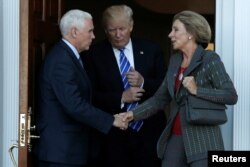Elizabeth "Betsy" DeVos — wealthy philanthropist, political donor, and advocate of private and charter schools — is the president-elect's nominee for U.S. secretary of education.
If confirmed, DeVos would oversee about 50.4 million students who attend about 100,000 public schools and 34,000 private schools. About 35 million students are in pre-kindergarten through eighth grade. About 15 million are in high school, or ninth through 12th grades.
Another 5 million students attend private elementary and secondary schools, according to the National Center for Education Statistics.
In her home state of Michigan, DeVos has advocated "school choice" and charter schools. That approach does not rely on children attending school in or near the neighborhoods where they live, which has traditionally been the model for U.S. public education. Instead, it advocates that children attend schools where the educational philosophy is compatible with the student's and parent's beliefs, such as same-gender or religious schools.
DeVos is a member of the Reformed Christian movement that has roots in Dutch religion and immigration. Michigan is home to the United States' largest number of Dutch-Americans, including the DeVos family.
The DeVos family built the Amway company, ranked as the 29th-largest American private business. Amway started as a cleaning supplies company in 1959 built on a direct-sales model. The company organizes a network of independent sellers and offers them sales incentives.
Education policy responsibilities
The education secretary oversees one of Washington's smaller agencies that "establishes policy for, administers and coordinates most federal assistance to education," according to the agency's website.
The Cabinet position also assists the president with education policy and legislation. The department's mission "is to serve America's students — to promote student achievement and preparation for global competitiveness by fostering educational excellence and ensuring equal access."
The U.S. Department of Education is relatively small (No. 16) compared with other agencies, such as Defense (No. 1), Justice (No. 4) or Transportation (No. 9). The department began in the mid-1800s as a way to collect statistics about American education.
But in the 1950s — relative to the post-World War II baby boom — it expanded. The department's "About Us" description points to the 1957 launch of the Soviet Union's Sputnik satellite as a driving force behind increased aid for U.S. science programs.
President Lyndon Johnson stepped up efforts in the 1960s by improving education for poor students. Those programs benefited racial minorities, women, the disabled and non-English speakers in gaining "equal access to education."
In 1980, the department was formally assembled into an agency and now has nearly 4,300 employees and a budget of about $60 billion, according to its website.
Politics and education policy
The U.S. Constitution mandates that states are responsible for primary and secondary education, or kindergarten through high school. Most of the funding for local public schools comes from state and local public taxes. The federal government adds about 8.3 percent more to the pot. The remainder of the funding for local education, about 8.9 percent, comes from private sources, primarily for private schools.
DeVos and her organization — the American Federation for Children — advocate for "school choice," or more federal funding to be channeled to private and charter schools.
Opinions about the department typically run along traditional political party lines: Democrats call for increased funding; Republicans call for decreased funding. Some politicians have suggested that the Department of Education be abolished, allowing the states to have more freedom to govern their schools.
Falling test scores in U.S. schools that show the country lagging behind other industrialized nations have caused consternation in recent years.
Some critics, educators and families have blamed programs such as the No Child Left Behind Act, signed into law by former President George W. Bush, and Common Core, an educational initiative promoted by software billionaires Bill and Melinda Gates.
Some educators take issue with DeVos, who lacks experience in the public school system, either as a student, parent, teacher or volunteer. DeVos is from a wealthy Christian family that wants to provide families with more flexibility in choosing a private education.
The next education secretary will also need to address the issue of for-profit colleges and universities. Several agencies within the Obama administration investigated the efficacy and cost of for-profit schools.
The education business of President-elect Donald Trump — Trump University — settled out of court with the federal government after it was accused of not providing to students the education it had advertised. Other for-profit schools have come under similar fire.
Tuition for education at colleges and universities has multiplied in the past 35 years. Students and families lament that higher education has become too expensive and burdensome, while job opportunities and wages have lagged.







